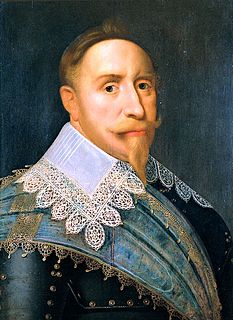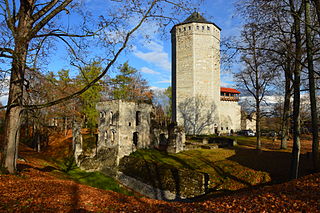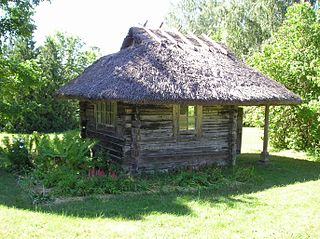 W
WThe Dorpat Voivodeship was a unit of administrative division and local government in the Duchy of Livonia, part of the Polish–Lithuanian Commonwealth, from 1598 until the Swedish conquest of Livonia in the 1620s. The seat of the voivode was in the town of Dorpat (Tartu), while the regional assembly (sejmik) for the whole province of Livonia was located in Wenden. The area of the Dorpat Voivodeship was app. 9,000 square kilometers, and it had two senators in the Senate of the Polish–Lithuanian Commonwealth.
 W
WEstonia under Swedish rule signifies the time between 1561 and 1710, when parts of present-day Estonia were under Swedish rule. In the wake of the breakup of the State of the Teutonic Order, the Baltic German local aristocracy in the areas of Harrien (Harjumaa) and Wierland (Virumaa), as well as the city of Reval (Tallinn) in June 1561 asked for and were granted protection by the Swedish king Eric XIV, leading to Swedish involvement in the Livonian War. At the conclusion of hostilities in 1583, Sweden was in control of the northern parts of modern Estonia and Hiiumaa island; this territory was created the Duchy of Estonia. Following renewed wars between Poland and Sweden, the southern parts of present-day Estonia were incorporated into Sweden by the Treaty of Altmark in 1629. In 1645, Denmark also ceded the island of Ösel (Saaremaa) to Sweden, and the latter was in control of all of present-day Estonia.
 W
WThe Battle of Narva on 30 November [O.S. 19 November] 1700 was an early battle in the Great Northern War. A Swedish relief army under Charles XII of Sweden defeated a Russian siege force three to four times its size. Previously, Charles XII had forced Denmark–Norway to sign the Treaty of Travendal. Narva was not followed by further advances of the Swedish army into Russia; instead, Charles XII turned southward to expel August the Strong from Livonia and Poland-Lithuania. Tsar Peter the Great of Russia took Narva in a second battle in 1704.
 W
WThe Parnawa Voivodeship was a unit of administrative division and local government in the Duchy of Livonia, part of the Polish–Lithuanian Commonwealth, since it was formed in 1598 until the Swedish conquest of Livonia in the 1620s. The seat of the voivode was Parnawa (Pärnu).
 W
WThe Polish–Swedish War (1600–1611) was a continuation of struggle between Sweden and the Polish–Lithuanian Commonwealth over control of Livonia and Estonia, as well as the dispute over the Swedish throne between Charles IX of Sweden and Sigismund III of Poland.
 W
WThe Polish–Swedish War of 1621 to 1625 was a war in a long-running series of conflicts between the Polish–Lithuanian Commonwealth and the Swedish Empire. It began with a Swedish invasion of the Polish–Lithuanian fiefdom Livonia. Swedish forces succeeded in taking the city of Riga after a siege. The Commonwealth, focussed on war with the Ottoman Empire, was unable to send significant forces to stop Gustav Adolf, and signed a truce favorable to Sweden. The Commonwealth ceded Livonia north of the Dvina (Düna) river, and retained only nominal control over Riga. The new truce in Mitau was signed and lasted from November 1622 to March 1625.
 W
WThe Siege of Fellin took place between 25 March and 17 May 1602 during the Polish–Swedish War (1600–1611). Polish and Lithuanian forces led by Grand Crown Hetman Jan Zamoyski besieged the Swedish-held town of Fellin. The large Polish–Lithuanian army of around 5,000 troops first took the town, while the Swedish defenders, numbering around 800, retreated to the city's castle. After a second frontal attack on the castle, during which the Voivode of Wenden Jerzy Farensbach was killed, the Swedish garrison capitulated, although a group of Finnish soldiers refused to surrender and blew themselves up in the castle's tower. Fellin was later recaptured by the Swedes in the siege of 1608.
 W
WThe Siege of Pärnu took place between February 28 and March 2, 1609 during the Polish–Swedish War (1600–1611).
 W
WThe Siege of Weissenstein took place between May 31 and September 30, 1602, during the Polish–Swedish War (1600–11). Two weeks after the capture of Fellin, Grand Crown Hetman Jan Zamoyski led the Polish-Lithuanian army of 2,000 troops to besiege Weissenstein. Weissenstein, a major transportation hub in Estonia, was a site of strategic importance to both Poland and Sweden. Located among the marshes and built during the Teutonic period, the castle had strong artillery and was defended by 700 soldiers, local peasants, and townspeople. Weissenstein was a walled city with 30-meter towers at the corners and high bastions, and thus presented the attacking force with a significant barrier to success, even with siege works.
 W
WThe Treaty of Cardis was a peace settlement made in 1661 between Tsardom of Russia and the Swedish Empire. This particular agreement ended the Russo–Swedish War (1656–1658). It took place in Cardis Manor in Estonia. Based on the terms of the treaty, Russia surrendered to Sweden all captured territories. Moreover, all vessels constructed at Kokenhausen for the failed Russian siege of Riga were destroyed. Overall, the Peace of Cardis maintained the territorial accords of the Treaty of Stolbovo.